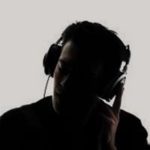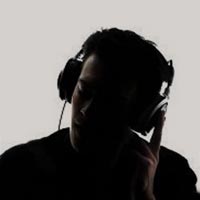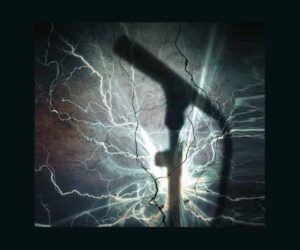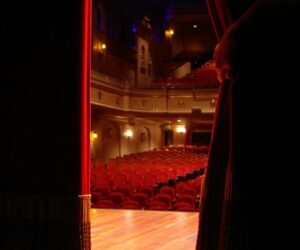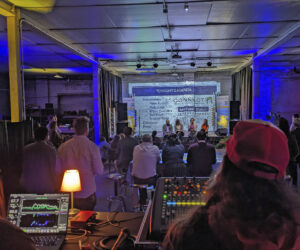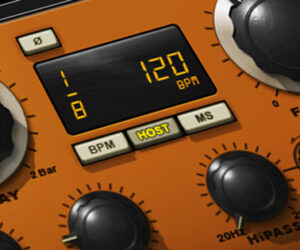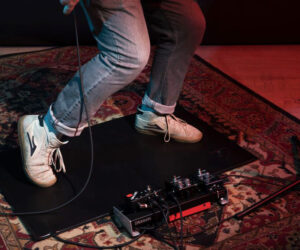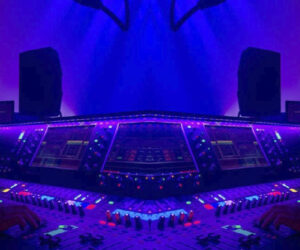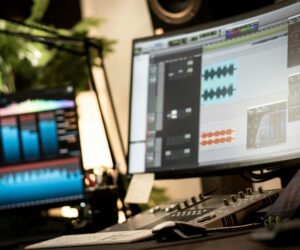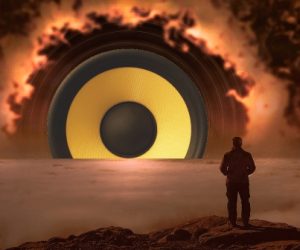Whether performing among blinding flashes of pyro, reaching out to confetti-speckled fans clamoring along the thrust, scrambling catlike over ramps and railings, or shimmering with dance moves set to throbbing percussion, Enrique Iglesias and Ricky Martin are two Latin stars who complement each other while simultaneously remaining different.
Iglesias’ role in this narrative finds its roots in his coolness quotient, which serves as a worthy counterpart to Martin’s intensity along a broader spectrum of Latin pop that has continued to explode over the last decade. Utilizing this alchemy to lay the foundation of a 26-date, co-headlining North American tour launched in late September of last year at the MGM Grand Garden Arena in Las Vegas that wrapped in late November at Anaheim’s Honda Center, the duo was served by an audio inventory brought to the task by Sound Image.
Well-seasoned live sound veterans made up the nucleus of the crew supporting the tour, with Brad Divens and Eddie “El Brujo” Caipo respectively occupying front of house and monitoring roles within the Iglesias camp while Jorge Frontera and César Benítez performed the same duties for Martin. System engineering fell under the supervision of Brendan Hines of Sound Image.
“This show took up a tremendous amount of real estate wherever it went,” Hines says, “and that fact alone created one of our biggest challenges in terms of consistency. The sheer size of things made squeezing everything into the different venues and keeping our sound the same a real trick. The response curve we tuned to could be dramatically different each day.”
Spanning 270 degrees in coverage, the house rig was based around JBL Professional dual-12 VTX A12 loudspeakers, which on average were flown 24 cabinets deep per side in the main arrays left-and-right along with nine VTX S28 subwoofers. Up to 18 VTX A12s formed what the crew called the auxiliary or side arrays, while up to 14 more VTX A12s formed the rear arrays bringing coverage to seating areas extending 28-30 feet upstage from the downstage edge.

Eighteen more ground-dwelling VTX G28 subs buttressed the low-end from hidden locations under the stage. Just above, a half-dozen front fill VTX V20s lined-up along the lip of the stage, divided evenly along either side of the thrust.
Coordinated Efforts
For Hines the challenge of bringing consistency to the rig every night began with deployment. Tuning, is his estimation, was an easier process, as the crew was dealing with a known benchmark. Getting to that place, however, was the hard part, especially when considering all the moving pieces that changed from stop-to-stop, including an enormous amount of video and lighting elements. It took the coordinated efforts of everyone on the lighting, video, and audio teams to ensure that everything was in the right place at the right time.
“There were two distinctly different mixing styles in the house for Enrique and Ricky,” Hines explains. “They both utilized the same starting point, but from there they diverged dramatically. These starting points can be compared to giving an artist a blank canvas to paint on. It’s a neutral thing at the outset. What he or she does with it from there is where an individual adds their own unique technique and coloration.

“It was the same thing for Brad and Jorge on this show, only in an aural sense. My goal was to prepare that canvas for each of them. Using an analogy from the art world once again, if I was Bob Ross, I wanted to give them what they needed to make happy trees. The trees may have required a few changes to adapt to each location, but all we had to do was touch them up appropriately to make them happy again.”
Much was to be done every day when it came to deployment, starting in the morning when Hines came in and measured the room using LAC-III and the Rational Acoustics Smaart platform found inside JBL Performance Manager software. Speeding up the measurement process by using wireless mics instead of dragging around hardwired transducers and their cumbersome cable, Hines brought even more time efficiency to the process by adding EQ and filtering he knew he would need in advance of show dates.
“Once we got to the point where both the tuning and deployment were done,” he notes, “then we could actually load all of our parameters and send them to the amps, which in this case were Crown I-Tech four-channel 4X3500HDs for our full-range boxes, and two-channel 12000HDs on the subs. Lake LM44 units provided processing. I had the house consoles for Enrique and Ricky’s shows, plus our opener, Colombian singer/songwriter Sebastian Yatra, all hooked up to one of XTA’s MX36 console switching systems. With just this one little box I was able to switch between consoles instantly. I just kept rotating between them as needed, no one knew it was even there.”
Methodical Approach
It took 15 trucks to move the entire show from town to town. Among the gear rolling onto the dock at each load-in was Brad Divens’ Yamaha RIVAGE PM10, a board he selected in large part to keep all his processing inside the box.
Having stood in the house for Iglesias for seven years now, Divens says that “The first time I used the RIVAGE PM10 and started bringing up inputs I never once thought I needed anything else outside of what the desk offered. Rupert Neve’s name being on it as well as on some of the plugins that I chose to use, that said it all to me.”
He set up the inputs on his desk in a fashion where all drums were assigned to a VCA. Inputs for bass, guitar, and keyboards were assigned to a VCA in a similar fashion, giving him control over all these inputs with a single fader each. He also took all instruments and assigned them to a separate VCA minus the vocals.
“That way I could control just the band with a single VCA,” he explains. “I also assigned the drums to two groups, and both these groups were processed with compression and EQ. One was processed very minimally with a tiny bit of compression, and the second one I squashed harder using parallel compression.

“I did the same thing to the bass after assigning it to two different groups. Guitars were bused to a group. Tracks, background vocals, percussion, you name it, there was a multitude of subgroups. Subgroups determined the balance of the mix as far as how much parallel compression I’d be using. The sum of all this is that I could mix the show with the VCAs.”
Inspired by a technique he learned from recording engineer Andrew Scheps, Divens additionally took all his inputs minus the drums and percussion and bused them through to a group and compressed it. “Then I would bring all of that up into the mix until it just started enhancing it in a way that I found I liked,” he adds. “That’s a studio trick I saw him do and decided to try live. It turned out that it worked pretty well. He refers to the technique as creating a ‘rear bus.’ It brought this extra little bit of presence in the mix to the instruments and vocals and made them stand out a little more.”
Capture & Control
Iglesias’ vocal mic utilized a DPA d:facto 4018V supercardioid capsule mounted atop a Shure Axient Digital AD2 wireless stick. Input for backing vocals were split between the same d:facto capsule/Shure stick combos as well as wireless Shure Beta 58s.
Iglesias and company started using DPA microphones back in 2017, and by the time this tour got off the ground last September, the stage was given over almost entirely to the brand with DPA twin-diaphragm 2011Cs rising above the drum kit as overheads, on hi-hat, and snare tops. Snare bottom relied upon DPA 4099s, as did the toms, congas, and timbales.
With instrument input largely being managed directly via Radial passive DIs and XLR connections at line-level, the sole exception to this DPA-dominant input scheme was a lone Shure Beta 91A used inside the kick drum.
“I used my RIVAGE PM10’s Rupert Neve Silk Red processing on the input of Enrique’s vocal chain,” Divens says. “From there his vocals went through the desk’s Rupert Neve 5045 Primary Source Enhancer into a Portico five-band 5033 EQ emulation and then into a dynamic EQ plug-in followed by a Rupert Neve Portico 5043 analog compressor emulation. I used the dynamic EQ to deal with however he was handling the mic – with proximity effect, whatever – then the compressor just brought it all together.
“The 5045 Primary Source Enhancer kept the audience out of the mic, kind of like a gate but not really a gate if that makes sense, and this was essential, as Enrique spends a lot of time with the crowd out on the thrust. It was great for controlling feedback as well.”

While Divens may have shunned the use of outboard gear entirely, his counterpart, Jorge Frontera at front of house for Ricky Martin, had no compunctions against stacking up an additional box or two next to his DiGiCo SD5 that included a Shelford Channel mic preamp, inductor EQ, diode bridge compressor from Rupert Neve Designs, and a standalone box version of the Rupert Neve Portico 5045.
“My outboard gear was for Ricky’s vocals,” Frontera points out. “Using the Shelford Channel Silk/Texture transformer saturation allowed me to get the tone I wanted really fast, while the 5045 Enhancer was great to eliminate background bleed into the mic. I also used a Bricasti Model 7 stereo reverb processor with remote control, it gave his voice an even higher level of musicality.”
Frontera integrated a pair of Waves SoundGrid servers with his SD5 via an external PC. His main plugins included a C6 multiband compressor, the Portico 5045, and an Abbey Road bundle that he spread across his subgroups.
“I had subgroups for everything,” he adds, “and snapshots for each song and the transitions between songs that recalled timing controlled by MIDI and SMPTE. A MOTU Micro Express USB MIDI interface converted time codes sent from Pro Tools. All my snapshots were controlled automatically, which was a great help in that it allowed me to focus wholly upon my mixing, not recalling snapshots.”
Studio To The Stage
Born in LA and raised in Peru, Eddie “El Brujo” Caipo managed monitors for Iglesias from behind an Avid S6L-32D. Caipo acquired his “El Brujo” moniker (“The Sorcerer” in Spanish) during his early days mixing in Bay Area bars for a band called Orixa he eventually joined. Back then he could take the worst clapped-out rigs in the region and somehow either make them sound good or at least passably much better, seemingly through some sort of wizardry, and thus the nickname, which stuck.
Relying more these days on technology after 10 years with Iglesias, Caipo has a tendency to use plugins more associated with studio work as opposed to the stage. “I also have a studio background,” he says. “So I’m comfortable with those kinds of tools. My common go-tos include offerings from McDSP, Plugin Alliance, Waves, Empirical Labs, and Universal Audio. Musicians onstage usually want to hear a mix that is either record balanced or front of house balanced. On this tour I emulated what was mastered on the records for those that wanted it that way, and I found that my studio-style plugins were perfect for that, as well as making everything fit into tiny in-ear drivers.”
Caipo had 90 inputs arriving at his desk. Within his stage blueprint 18 PSM 1000 channels of Shure wireless and four hardwired channels provided 22 stereo mixes for the band, Enrique, techs, the video and lighting crews, stage manager, and some spares.
“Enrique likes reverb,” Caipo says. “I kept his channel strip pretty straightforward with some multiband compression, standard high-pass filtering, low-mid cut to deal with occlusion effect, and a bit of boost on the high frequencies to brighten it up a little. He prefers to keep things crisp like a lot of singers do.
“What was really critical was the main bus processing I had, not just for him but for everyone. There I used Brainworx Audio plugins for my mid-side EQ, and a Universal Audio FATSO to warm things up and add some light compression. In the last stage an ML4000 Mastering Limiter and multiband dynamics processor from McDSP served as a brick wall limiter, while some very light multiband compression was used just to clean things up before everything headed out to the IEMs onstage. I created the curve supporting each musician’s mix along the way, that allowed me to do a lot less processing of the individual channels and provided a version of what the mix should sound like tailored specifically for each musician.
“Beyond selecting the right tools, for me having a great team by my side was critical. My stage left compatriots Evan McGowen and Stephanie Van Ravensway definitely deserve a big thanks for fulfilling that role on this show.”
Making It Immersive
Caipo’s colleague in monitor world for Ricky Martin was César Benítez. Orchestrating his work from behind a DiGiCo SD5 receiving 102 inputs, his efforts on this tour were notable for the approach he took using KLANG immersive in-ear processing.
“I had worked with Ricky before this tour on award shows and when he was a guest on shows of other artists I work for, but never on one of his own shows,” Benítez explains. “He had no idea that we could apply immersive technology to our onstage sound. I began warming him up to the idea in rehearsals and it wasn’t long before he started appreciating the natural openness of the sound, not to mention the spatial realism that allowed me to place the instruments in his mix in the exact dimensions they were found onstage.

“For example, if the keyboards and percussion were behind and above him on a riser, that’s exactly where they were heard in his mix, it was like he wasn’t wearing in-ears at all. He eventually introduced the concept to the other musicians, and half the band wound up going with it too.”
Martin’s vocal mic was a Sennheiser SKM 6000. Shure PSM 1000 wireless channels were used by most everyone onstage with the exception of a couple musicians that chose to go hardwired.
A team player all the way, when space was tight onstage Benítez volunteered to move his mix position into the bleachers. “I’m accustomed to doing a lot of award shows and other broadcast work where real estate is always at a premium and forces me into odd places,” he says, shedding light upon the logic behind his choices to sometimes hole-up in unorthodox workspaces on the tour.
“So it was no big deal for me at all,” he continues. “I had talkback capabilities and a monitor so I could keep a close eye on Ricky and the stage – I really didn’t care where I was located. After way more than enough time off during the pandemic, I – like everyone else – was simply overjoyed to be working again and having a great time doing it every night.”


